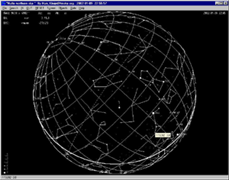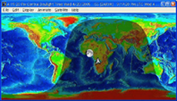You are here: Teaching Helps > General Education > Science Social Studies
Free Astronomy Programs
by Alan Ward
Recently I found three astronomy programs on the Internet that may be of interest to teachers. They are all free and for use on MS Windows platforms. Before
describing the programs, I want to mention that ![]() Sky and Telescope magazine provides useful information for beginning amateur astronomers.
Sky and Telescope magazine provides useful information for beginning amateur astronomers.
Hallo, Northern Sky (HNSky)

HNSky celestial sphere
Astronomers often portray the sky as a rotating sphere surrounding the earth with the stars and planets on the sphere’s surface since that is how things appear from earth. The celestial sphere is displayed by HNSky for any time, date, and location (including the southern hemisphere).
Where the ![]() Electric Astrolabe excels in providing solar system information, this program is great for identifying constellations and stars. The displayed celestial sphere can be rotated and zoomed. The user is allowed to specify how many stars to display (based on brightness) and whether to show planets, asteroids, and comets. There are aids for aiming a telescope, and extensive databases can also be downloaded from the HNSky website to show many more stars. Initially, you can just download the minimum files needed to run the program as described at the website.
Electric Astrolabe excels in providing solar system information, this program is great for identifying constellations and stars. The displayed celestial sphere can be rotated and zoomed. The user is allowed to specify how many stars to display (based on brightness) and whether to show planets, asteroids, and comets. There are aids for aiming a telescope, and extensive databases can also be downloaded from the HNSky website to show many more stars. Initially, you can just download the minimum files needed to run the program as described at the website.
Home Planet
![]() http://www.fourmilab.ch/homeplanet/
http://www.fourmilab.ch/homeplanet/

Home Planet horizon view
When first run, this Windows program displays a small topographic map of the earth showing where sunlight is currently shining. From this window, a traditional star chart can be displayed. Horizon views and zoomed views of the sky are available, too. This program also provides an object catalog and many other features, though the user interface is slightly awkward to use. Initially, you can download just the lite version of the program.
Summary
All of the programs provide more features than I have described here. In particular they all provide animated views of the sky showing how it changes over various time increments (such as minutes, hours, days, and years), and they display the location of Messier objects (nebula, galaxies, etc.). Hopefully you will download them and let your students explore them if they have an interest in astronomy. These programs are an improvement over traditional sky charts!
Alan Ward has worked for SIL since 1989. He currently works with computers and non-Roman scripts. Astronomy is a hobby of his.
